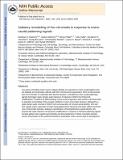Saltatory remodeling of Hox chromatin in response to rostrocaudal patterning signals
Author(s)
Mazzoni, Esteban O.; Mahony, Shaun; Peljto, Mirza; Patel, Tulsi; McCuine, Scott; Wichterle, Hynek; Thornton, Seraphim R.; Young, Richard A.; Reeder, Christopher; Gifford, David K; Boyer, Laurie Ann; ... Show more Show less
DownloadGifford_Saltatory remodeling.pdf (2.380Mb)
PUBLISHER_POLICY
Publisher Policy
Article is made available in accordance with the publisher's policy and may be subject to US copyright law. Please refer to the publisher's site for terms of use.
Terms of use
Metadata
Show full item recordAbstract
Hox genes controlling motor neuron subtype identity are expressed in rostrocaudal patterns that are spatially and temporally collinear with their chromosomal organization. Here we demonstrate that Hox chromatin is subdivided into discrete domains that are controlled by rostrocaudal patterning signals that trigger rapid, domain-wide clearance of repressive histone H3 Lys27 trimethylation (H3K27me3) polycomb modifications. Treatment of differentiating mouse neural progenitors with retinoic acid leads to activation and binding of retinoic acid receptors (RARs) to the Hox1–Hox5 chromatin domains, which is followed by a rapid domain-wide removal of H3K27me3 and acquisition of cervical spinal identity. Wnt and fibroblast growth factor (FGF) signals induce expression of the Cdx2 transcription factor that binds and clears H3K27me3 from the Hox1–Hox9 chromatin domains, leading to specification of brachial or thoracic spinal identity. We propose that rapid clearance of repressive modifications in response to transient patterning signals encodes global rostrocaudal neural identity and that maintenance of these chromatin domains ensures the transmission of positional identity to postmitotic motor neurons later in development.
Date issued
2013-08Department
Massachusetts Institute of Technology. Computer Science and Artificial Intelligence Laboratory; Massachusetts Institute of Technology. Department of Biology; Massachusetts Institute of Technology. Department of Electrical Engineering and Computer Science; Whitehead Institute for Biomedical ResearchJournal
Nature Neuroscience
Publisher
Nature Publishing Group
Citation
Mazzoni, Esteban O, Shaun Mahony, Mirza Peljto, Tulsi Patel, Seraphim R Thornton, Scott McCuine, Christopher Reeder, et al. “Saltatory Remodeling of Hox Chromatin in Response to Rostrocaudal Patterning Signals.” Nat Neurosci 16, no. 9 (August 18, 2013): 1191–1198.
Version: Author's final manuscript
ISSN
1097-6256
1546-1726